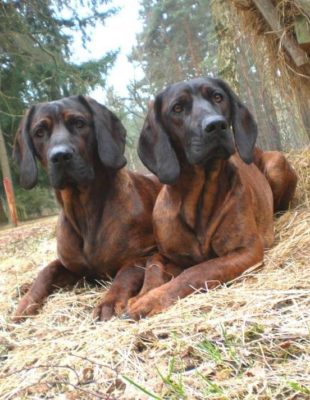Hanover Hound
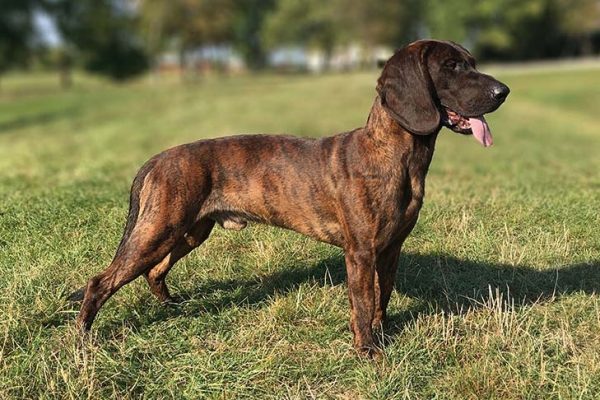
Calm and obedient as a pet, irrepressible during the pursuit of prey. Within the Hanover Hound and other breeds of the hound group, there are two different characters – phlegmatic and sanguine. On the one hand, quiet and compliant are energetic with a quick independent reaction to any unforeseen circumstances.
Table of Contents
Breed Information
| Another Name | Hanoverian Hound, Hanoverian Scenthound, Hannover’scher Schweisshund |
| Origin | Germany |
| Height | Males 50-55 cm Females 48-53 cm |
| Weight | 25-40 kg |
| Fur | Short |
| Color | Redhead |
| Lifespan | 10-15 years |
| FCI Classification | Scent hounds and related breeds |
| Group | Hunting dogs |
| Price | From $500-800 |
Breed Photos
Origin History
The Hanover Hound is a breed of hunting dogs and is considered one of the oldest European hounds. Its progenitors are Celtic dogs, which trace their origins back to the 5th century AD. Germanic tribes actively used native dogs in hunting. Since that time, the breed has undergone significant changes. A key event was the invention of firearms. In the nineteenth century, after the Hound and the German Hound crossing, an improved version of the Hanoverian Hound was first introduced in Hanover. Their main purpose is to hunt blood trails and track big games. Before the hunt, a pack of hounds was released to unravel the tracks of the prey. Today, the Hannoverian hounds are used for trail work and are highly valued for their excellent instinctive sense of smell, which never fails representatives of this breed. The first club of fans of the breed was opened in Germany in 1894.
Appearance
The Hanover Hound has a distinctive appearance: an elongated stocky body, straight limbs, and hanging ears tightly fitted to the head. The dog is of medium height but powerful enough, weighing up to 45 kg. Rounded and wide ribcage has a more voluminous build than other hounds. The long back with pronounced withers passes into a wide loin and a long tail with a slight suspension. She has well-developed brow arches and expressive transition from forehead to muzzle with the drooping mandibular crease. The short, smooth coat lengthens at the abdomen and on the back of the thighs. The color can be reddish-red in various shades with black patches on the hair’s ends and a mask on the muzzle.
Character
Calm and obedient as a pet, irrepressible during the pursuit of prey. Within the Hanover Hound and other breeds of the hound group, there are two different characters – phlegmatic and sanguine. On the one hand, quiet and compliant are energetic with a quick independent reaction to any unforeseen circumstances. He infinitely loves his master, is devoted to him and his family, he adores attention, asking to pet him at the first opportunity. Well get along with children, behave with them gently and patiently.
An excellent and unmistakable sense of smell allows the dog to show itself as a hunter and as a watchdog. When encountering strangers, behave coldly and warily, thus showing his distrust of humans. It can also be dangerous to other animals; in a burst of hunting, instincts can pounce violently on the poor dog.
Care
Exhausting running is the first thing a Hanover Hound strives for. Unfortunately, it is quite problematic in the city to provide free walking or constant access to the outdoors. You have to be prepared for hours of outdoor training. If you are involved in running or avid hunting, then this dog is definitely for you! The coat does not require thorough care; wiping a couple of times a week with a towel or, at most, a wet hand is enough.
Training
A confident person should buy a hunting dog. The Hanover Hound has an independent personality, and productive training requires a firm owner’s hand and consistency. Seemingly quiet and calm, the Hound can give you a hard time. Whether you bought it for hunting or as a pet, you should provide it with plenty of open space and an adequate level of exercise.
Common Diseases
The Hanover Hound boasts naturally robust health, which accounts for their physical stamina. Large, wide ears that hang straight down over the head indicate possible problems with the ear canal. Inadequate ventilation contributes to inflammation and its chronic course. The ear canal should be thoroughly cleaned to prevent infection by wiping it gently with a damp cloth. If redness or unpleasant odor comes out of the ear canal, seek veterinary care immediately.
The most common diseases of the Hanover Hound include:
- hip dysplasia;
- cancer;
- ingrown claws;
- chronic ear infections;
- sensitivity to anesthesia;
- obesity;
- gastric torsion.
Nutrition
The Hanover Hound is a rather large pet, and you will need about a pound of meat daily to feed such a dog. It is offered to the Hound in raw form, cut into pieces. Of vegetables and cereals, soups and porridges are prepared, the vitamin and mineral composition is enriched by adding bone meal and ordinary table salt. It is recommended to use two drops of multivitamins in the diet of dogs with this weight. Sub-products such as chicken heads, necks, and ruminants are also considered useful for hound breeds.
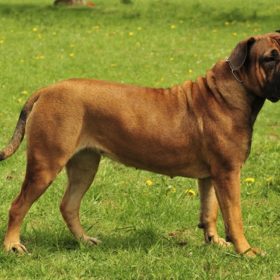 Boerboel
Boerboel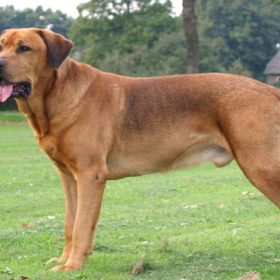 Broholmer
Broholmer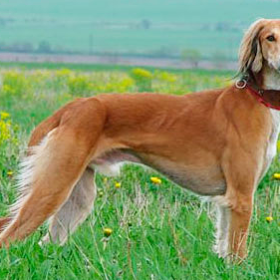 Tazy
Tazy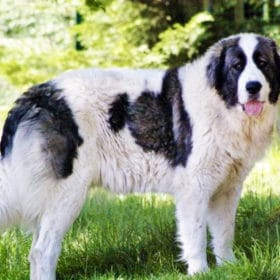 Bucovina Shepherd Dog
Bucovina Shepherd Dog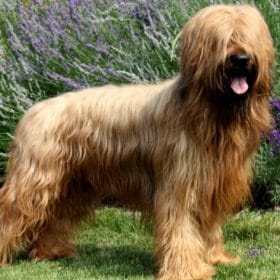 Briard
Briard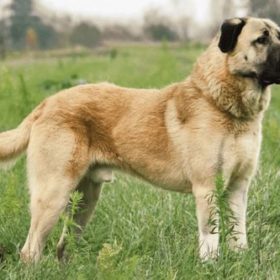 Kangal Shepherd Dog
Kangal Shepherd Dog
